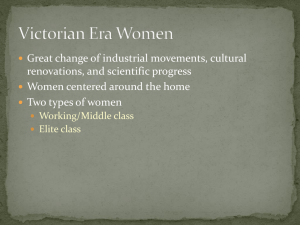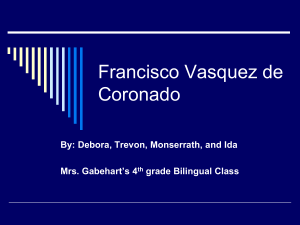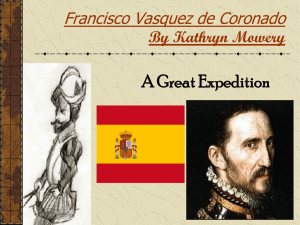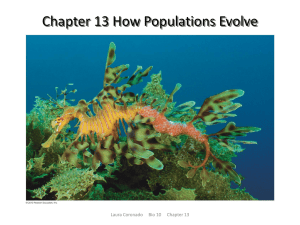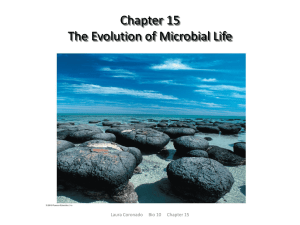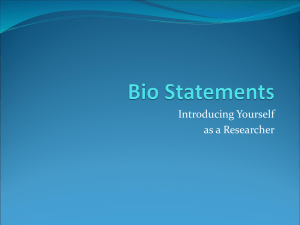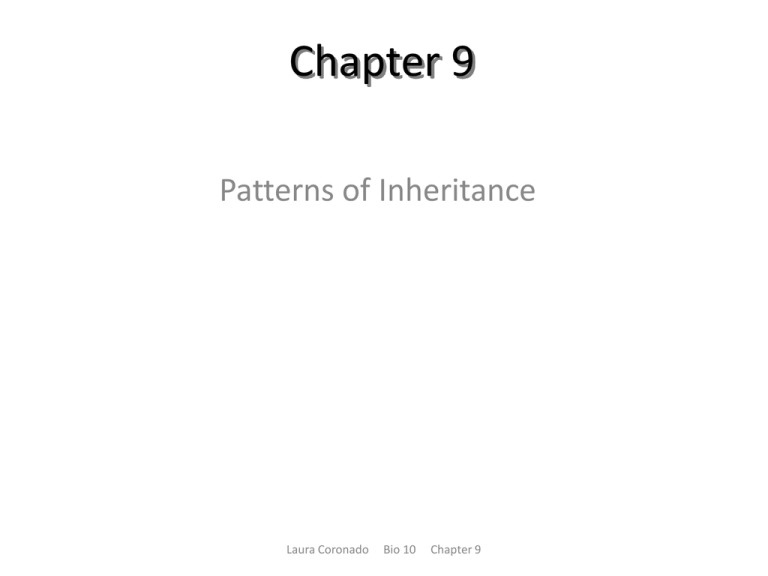
Chapter 9
Patterns of Inheritance
Laura Coronado
Bio 10
Chapter 9
Biology And Society:
A Matter of Breeding
• Genetics is the scientific
study of heredity.
– Genetics explains why the
offspring of purebred dogs
are like their parents.
– Inbreeding of dogs makes
some genetic disorders
common.
– A dog’s behavior is
determined by its
• Genes
• Environment
Laura Coronado
Bio 10
Chapter 9
HERITABLE VARIATION AND PATTERNS OF
INHERITANCE
– Heredity is the
transmission of traits from
one generation to the next.
– Gregor Mendel
• Worked in the 1860s
• Was the first person to
analyze patterns of
inheritance
• Deduced the fundamental
principles of genetics
Laura Coronado
Bio 10
Chapter 9
In an Abbey Garden
– Mendel studied
garden peas
because they
• Are easy to grow
• Come in many readily
distinguishable
varieties
• Are easily
manipulated
• Can self-fertilize
Laura Coronado
Petal
Stamen
(makes spermproducing
pollen)
Carpel
(produces
eggs)
Bio 10
Chapter 9
Definitions
• A character is a heritable feature that varies among
individuals.
• Flower color
• A trait is a variant of a character.
• Purple or white flower color
• Each of the characters Mendel studied occurred in
two distinct forms.
Laura Coronado
Bio 10
Chapter 9
– Mendel
• Created true-breeding varieties of plants
– Purple & white pea flowers
• Crossed two different true-breeding varieties
• A monohybrid cross is a cross between parent
plants that differ in only one character.
– Hybrids are the offspring of two different
true-breeding varieties.
• The parental plants are the P generation.
• Their hybrid offspring are the F1 generation.
• A cross of the F1 plants forms the F2 generation.
Laura Coronado
Bio 10
Chapter 9
White
Removed
stamens
from purple
flower.
Stamens
Parents
(P)
Carpel
Purple
Transferred pollen from
stamens of white flower
to carpel of purple
flower.
Pollinated carpel
matured into pod.
Planted seeds
from pod.
Offspring
(F1)
Laura Coronado
Bio 10
Chapter 9
Figure 9.3-3
Mendel’s Law of Segregation
– Mendel performed many
experiments.
– He tracked the inheritance
of characters that occur as
two alternative traits.
Laura Coronado
Bio 10
Chapter 9
Dominant
Dominant
Recessive
Flower color
Recessive
Pod shape
Purple
White
Flower position
Inflated
Constricted
Green
Yellow
Tall
Dwarf
Pod color
Stem length
Axial
Terminal
Yellow
Green
Round
Wrinkled
Seed color
Seed shape
Laura Coronado
Bio 10
Chapter 9
Figure 9.4
P Generation
(true-breading
parents)
Purple flowers
F1 Generation
White flowers
All plants have
purple flowers
Fertilization
among F1 plants
(F1 F1)
F2 Generation
3
of plants
4
have purple flowers
1
of plants
4
have white flowers
Figure 9.5-3
Mendel developed four hypotheses from
the monohybrid cross:
1. There are alternative versions of genes,
called alleles.
2. For each character, an organism inherits two
alleles, one from each parent.
– An organism is homozygous for that gene if
both alleles are identical. Called a homozygote.
– An organism is heterozygous for that gene if the
alleles are different. Called a heterozygote.
Laura Coronado
Bio 10
Chapter 9
Mendel developed four hypotheses from
the monohybrid cross
3. If two alleles of an inherited pair differ
– The allele that determines the organism’s appearance is
the dominant allele
– The other allele, which has no noticeable effect on the
appearance, is the recessive allele
4. Gametes carry only one allele for each inherited
character.
– The two members of an allele pair segregate (separate)
from each other during the production of gametes.
– This statement is the law of segregation.
Laura Coronado
Bio 10
Chapter 9
P Generation
Genetic makeup (alleles)
Purple flowers
PP
Alleles carried
White flowers
pp
by parents
Gametes
All p
All P
F1 Generation
(hybrids)
Purple flowers
All Pp
Alleles
segregate
Gametes
1
P
2
F2 Generation
(hybrids)
Sperm from
F1 plant
p
P
P
Eggs from
F1 plant
1 p
2
PP
Pp
Pp
pp
p
Phenotypic ratio
3 purple : 1 white
Laura Coronado
Bio 10
Genotypic ratio
1 PP : 2 Pp : 1 pp
Chapter 9Figure 9.6-3
– Geneticists distinguish between an
organism’s physical traits and its genetic
makeup.
• An organism’s physical traits are its phenotype.
• An organism’s genetic makeup is its genotype.
– Homologous chromosomes have
• Genes at specific loci
• Alleles of a gene at the same locus
Laura Coronado
Bio 10
Chapter 9
Gene loci
Homologous
chromosomes
Dominant
allele
P
a
B
P
a
b
Recessive
allele
Genotype:
PP
Homozygous
for the
dominant allele
Laura Coronado
Bio 10
aa
Homozygous
for the
recessive allele
Chapter 9
Figure 9.7
Bb
Heterozygous
Mendel’s Law of Independent Assortment
– A dihybrid cross is the crossing of parental
varieties differing in two characters.
– What would result from a dihybrid cross? Two
hypotheses are possible:
1. Dependent assortment
2. Independent assortment
Laura Coronado
Bio 10
Chapter 9
Law of Independent Assortment
– Mendel’s dihybrid cross supported the
hypothesis that each pair of alleles
segregates independently of the other pairs
during gamete formation.
– Thus, the inheritance of one character has no
effect on the inheritance of another.
– Independent assortment is also seen in two
hereditary characters in Labrador retrievers.
Laura Coronado
Bio 10
Chapter 9
(a) Hypothesis: Dependent assortment
(b) Hypothesis: Independent assortment
P Generation
RRYY
RRYY
rryy
Gametes RY
ry
F1 Generation
rryy
ry
Gametes RY
RrYy
RrYy
Sperm
F2 Generation
1
RY
4
1 rY
4
1 Ry
4
1 ry
4
1
RY
4
RRYY
RrYY
RRYy
RrYy
1
rY
4
RrYY
rrYY
RrYy
rrYy
Sperm
1
2 RY
1
ry
2
1
2 RY
Eggs
Eggs
1
ry
2
1 Ry
4
1 ry
4
Predicted results
(not actually seen)
Laura Coronado
Bio 10
RRYy
RrYy
RRyy
Rryy
rrYy Rryy rryy
Actual results
(support hypothesis)
Chapter 9
Figure 9.8
RrYy
9
16
3
16
3
16
1
16
Yellow
round
Green
round
Yellow
wrinkled
Green
wrinkled
Blind dog
Blind dog
Phenotypes
Black coat,
Black coat,
blind (PRA)
normal vision
B_N_
Genotypes
B_nn
(a) Possible phenotypes of Labrador retrievers
Chocolate coat,
normal vision
bbN_
Chocolate coat,
blind (PRA)
bbnn
Mating of double heterozygotes
(black coat, normal vision)
BbNn
BbNn
Phenotypic
ratio of
offspring
9 black coat,
normal vision
3 black coat,
blind (PRA)
3 chocolate coat,
normal vision
(b) A Labrador dihybrid cross
Laura Coronado
Bio 10
Chapter 9
Figure 9.9
1 chocolate coat,
blind (PRA)
Using a Testcross to Determine an Unknown
Genotype
– A testcross is a mating between
• An individual of dominant phenotype (but unknown
genotype)
• A homozygous recessive individual
Laura Coronado
Bio 10
Chapter 9
Testcross
B_
Genotypes
bb
Two possible genotypes for the black dog:
BB
Bb
or
Gametes
B
B
Offspring
b Bb
All black
b Bb bb
1 black : 1 chocolate
Laura Coronado
Bio 10
Chapter 9
Figure 9.10
b
The Rules of Probability
– Mendel’s strong background in mathematics
helped him understand patterns of inheritance.
– The rule of multiplication states that the
probability of a compound event is the product of
the separate probabilities of the independent
events.
Laura Coronado
Bio 10
Chapter 9
F1 Genotypes
Bb female
Bb male
Formation of sperm
Formation of eggs
F2 Genotypes
Male gametes
Female gametes
1
2
1
2
1
2
B
B
b
1
2
B
B
b
B
b
1
1 4 1
( 2 2)
B
b
Laura Coronado
1
4
1
4
b
b
1
4
Bio 10
Chapter 9
Figure 9.11
– Mendel’s principles apply to the inheritance
of many human traits.
– A family pedigree
• Shows the history of a trait in a family
• Allows geneticists to analyze human traits
– Dominant traits are not necessarily
• Normal or More common
– Wild-type traits are
• Those seen most often in nature
• Not necessarily specified by dominant alleles
Laura Coronado
Bio 10
Chapter 9
DOMINANT TRAITS
Widow’s peak
Free earlobe
No freckles
Straight hairline
Attached earlobe
RECESSIVE TRAITS
Freckles
Laura Coronado
Bio 10
Chapter 9
Figure 9.12
First generation
(grandparents)
Second generation
(parents, aunts, and
uncles)
Third generation
(brother and
sister)
FF
or
Ff
ff
Ff
Ff
Ff
ff
ff
FF
or
Ff
Ff
Ff
ff
ff
Female Male
Attached
Free
Laura Coronado
Bio 10
Chapter 9
Figure 9.13
Human Disorders Controlled by a Single Gene
– Many human traits
• Show simple inheritance patterns
• Are controlled by single genes on autosomes
– Recessive Disorders
• Most human genetic disorders are recessive.
• Individuals who have the recessive allele but
appear normal are carriers of the disorder.
Laura Coronado
Bio 10
Chapter 9
Laura Coronado
Bio 10
Chapter 9
Table 9.1
Parents
Hearing
Dd
Hearing
Dd
Offspring
D
D
Sperm
d
DD
Hearing
Dd
Hearing
(carrier)
Dd
Hearing
(carrier)
dd
Deaf
Eggs
d
Laura Coronado
Bio 10
Chapter 9
Figure 9.14
– Cystic fibrosis
• Is the most common lethal genetic disease in the
United States
• Is caused by a recessive allele carried by about
one in 25 people of European ancestry
– Prolonged geographic isolation of certain
populations can lead to inbreeding, the
mating of close relatives.
• Inbreeding increases the chance of offspring that
are homozygous for a harmful recessive trait.
Laura Coronado
Bio 10
Chapter 9
Dominant Disorders
– Some human genetic disorders are
dominant.
• Huntington’s disease, which leads to
degeneration of the nervous system, does not
begin until middle age.
• Achondroplasia is a form of dwarfism.
– The homozygous dominant genotype causes death of
the embryo.
– Thus, only heterozygotes have this disorder.
Laura Coronado
Bio 10
Chapter 9
Parents
Dwarf
Normal
(achondroplasia)
(no achondroplasia)
Dd
dd
d
D
Sperm
d
Dd
Dwarf
Dd
Dwarf
dd
Normal
dd
Normal
Eggs
d
Molly Jo
Laura Coronado
Bio 10
Amy
Matt
Chapter 9
Zachary
Figure 9.16
Jake
Jeremy
The Process of Science:
What Is the Genetic Basis of Hairless Dogs?
• Observation: Dogs come in a wide variety of physical types.
• Question: What is the genetic basis for the hairless phenotype?
• Hypothesis: A comparison of genes of coated and hairless
dogs would identify the gene or genes responsible.
• Prediction: A mutation in a single gene accounts for the
hairless appearance.
• Experiment: Compared DNA sequences of 140 hairless dogs
from 3 breeds with 87 coated dogs from 22 breeds.
• Results: Every hairless dog, but no coated dogs, had a single
change in a single gene.
Laura Coronado
Bio 10
Chapter 9
Laura Coronado
Bio 10
Chapter 9
Figure 9.17
Genetic Testing
– Today many tests can detect the presence of
disease-causing alleles.
– Most genetic testing is performed during
pregnancy.
• Amniocentesis collects cells from amniotic fluid.
• Chorionic villus sampling removes cells from
placental tissue.
– Genetic counseling helps patients
understand the results and implications of
genetic testing.
Laura Coronado
Bio 10
Chapter 9
VARIATIONS ON MENDEL’S LAWS
– Some patterns of genetic inheritance are not
explained by Mendel’s laws.
• In incomplete dominance in plants and people,
F1 hybrids have an appearance in between the
phenotypes of the two parents.
Laura Coronado
Bio 10
Chapter 9
P Generation
White
rr
Red
RR
Gametes
R
r
F1 Generation
Pink
Rr
Gametes
F2 Generation
1
1
r
2 R 2
Sperm
1
1
R
2 r
2
1
2 R
RR
Rr
Eggs
1
r
rr
Rr
2
Laura Coronado Bio 10 Chapter 9
Figure 9.18-3
Hypercholesterolemia
– Is characterized by dangerously high levels of
cholesterol in the blood.
– Is a human trait that is incompletely dominant.
– Heterozygotes have blood cholesterol levels about
twice normal.
– Homozygotes have blood cholesterol levels about
five times normal.
Laura Coronado
Bio 10
Chapter 9
GENOTYPE
HH
Homozygous
for ability to make
LDL receptors
Hh
Heterozygous
hh
Homozygous
for inability to make
LDL receptors
Mild disease
Severe disease
PHENOTYPE
LDL
LDL
receptor
Cell
Normal
Laura Coronado
Bio 10
Chapter 9
Figure 9.19
ABO Blood Groups: An Example of Multiple
Alleles and Codominance
– The ABO blood groups in humans are an example of
multiple alleles.
– The human blood type alleles IA and IB exhibit
codominance: Both alleles are expressed in the
phenotype.
– The immune system produces blood proteins called
antibodies that can bind specifically to blood cell
carbohydrates.
– Blood cells may clump together if blood cells of a different
type enter the body.
– The clumping reaction is the basis of a blood-typing lab
test.
Laura Coronado
Bio 10
Chapter 9
Blood
Group
Genotypes
(Phenotype)
Red Blood Cells
Antibodies
Present in
Blood
Reactions When Blood from Groups Below Is
Mixed with Antibodies from Groups at Left
A
B
AB
O
Carbohydrate A
A
IAIA
or
IAi
B
IBIB
or
IBi
AB
IAIB
—
O
ii
Anti-A
Anti-B
Anti-B
Carbohydrate B
Anti-A
Laura Coronado
Bio 10
Chapter 9
Figure 9.20
Pleiotropy and Sickle-Cell Disease
– Pleiotropy is the impact
of a single gene on more
than one character.
– Sickle-cell disease
• Exhibits pleiotropy
• Results in abnormal
hemoglobin production
• Causes disk-shaped red
blood cells to deform
into a sickle shape with
jagged edges
Laura Coronado
Bio 10
Chapter 9
Individual homozygous,
for sickle-cell allele
Sickle-cell (abnormal) hemoglobin
Colorized SEM
Abnormal hemoglobin crystallizes into long flexible chains,
causing red blood cells to become sickle-shaped.
Sickled cells can lead to a cascade of symptoms, such as
weakness, pain, organ damage, and paralysis.
Figure 9.21
Polygenic Inheritance
– Polygenic inheritance is the additive effects of
two or more genes on a single phenotype.
Laura Coronado
Bio 10
Chapter 9
P Generation
aabbcc
(very light)
AABBCC
(very dark)
F1 Generation
AaBbCc
F2 Generation
1
8
Sperm
1
1
8
8
1
8
1
8
1
8
1
8
1
8
1
8
1
8
1
8
1
8
1
8
1
8
1
8
20
64
Fraction of population
Eggs
1
8
AaBbCc
1
64
6
64
15
64
20
64
15
64
6
64
1
64
Skin pigmentation
1
15
6
64
64Bio 10 Chapter 9
64 Coronado
Laura
Figure 9.22
The Role of Environment
– Many human characters
result from a
combination of heredity
and environment.
– Only genetic influences
are inherited.
Laura Coronado
Bio 10
Chapter 9
THE CHROMOSOMAL BASIS OF
INHERITANCE
– The chromosome theory of inheritance
states that
• Genes are located at specific positions on
chromosomes
• The behavior of chromosomes during meiosis and
fertilization accounts for inheritance patterns
– It is chromosomes that undergo segregation
and independent assortment during meiosis
and thus account for Mendel’s laws.
Laura Coronado
Bio 10
Chapter 9
P Generation
Round-yellow seeds
(RRYY)
r y
Y
Y
Wrinkled-green seeds
(rryy)
R R
y
r
MEIOSIS
FERTILIZATION
Gametes
y
R Y
F1 Generation
R
r
Law of Segregation: Follow the long
chromosomes (carrying R and r) taking
either the left or right branch.
Y
y
r
Y
y
y
Y
Y
R
F2 Generation
Metaphase
II
r
Y
1
ry
4
:3
y
Y
r
1
rY
4
:3
y
Y
FERTILIZATION AMONG THE F1 PLANTS
9
They are arranged in either of
two equally likely ways at
metaphase I.
R
r
r
R
r
Y
y
r
1
RY
4
Fertilization recombines the r
and R alleles at random.
Law of Independent Assortment:
Follow both the long and the short
chromosomes.
Metaphase I
(alternative
arrangements)
r
R
R
y
MEIOSIS
The R and r alleles segregate in
anaphase I of meiosis.
Gametes
All round-yellow seeds
(RrYy)
Y
R
Only one long
chromosome ends
up in each gamete.
r
They sort independently,
giving four gamete types.
y
y
R
R
1
Ry
4
Fertilization results in the
9:3:3:1 phenotypic ratio in
the F2 generation.
:1
Figure 9.24-4
Linked Genes
– Linked genes
• Are located close together on a chromosome
• May be inherited together
– Using the fruit fly Drosophila melanogaster, Thomas
Hunt Morgan determined that some genes were
linked based on the inheritance patterns of their
traits.
Laura Coronado
Bio 10
Chapter 9
Dihybrid testcross
Gray body,
long wings
(wild-type)
Black body,
short wings
(mutant)
GgLl
ggll
Female
Male
Results
Offspring
Gray-long
GgLl
Black-short
ggll
Gray-short
Ggll
944
965
185
206
Recombinant phenotypes 17%
Parental phenotypes 83%
Laura Coronado
Black-long
ggLl
Bio 10
Chapter 9
Figure 9.25-2
Genetic Recombination: Crossing Over
– Crossing over can
• Separate linked alleles
• Produce gametes with recombinant
chromosomes
• Produce offspring with recombinant
phenotypes
– The percentage of recombinant offspring
among the total is called the recombination
frequency.
Laura Coronado
Bio 10
Chapter 9
A
B
a
b
a
B
A B
Parental gametes
a b
Pair of
homologous
chromosomes
A
Crossing over
b
Recombinant gametes
Laura Coronado
Bio 10
Chapter 9
Figure 9.26
GgLl
(female)
GL
gl
gl
gl
ggll
(male)
Crossing over
GL
gL
Gl
gl
gl
Sperm
Parental gametes
Recombinant gametes
Eggs
FERTILIZATION
Offspring
GL
gl
Gl
gL
gl
gl
gl
gl
Parental
Recombinant
Figure 9.27
Linkage Maps
– Early studies of crossing over were performed using
the fruit fly Drosophila melanogaster.
– Alfred H. Sturtevant, a student of Morgan,
developed a method for mapping gene loci, which
resulted in the creation of linkage maps.
• He reasoned that the greater the distance between 2
genes, the more points there are between them where
crossing over can occur
• A diagram of relative gene locations on a chromosome is
a linkage map.
Laura Coronado
Bio 10
Chapter 9
Chromosome
g
c
l
17%
9.5%
9%
Recombination
frequencies
Laura Coronado
Bio 10
Chapter 9
Figure 9.28
SEX CHROMOSOMES AND SEX-LINKED
GENES
– Sex chromosomes
influence the
inheritance of certain
traits.
– Nearly all mammals
have a pair of sex
chromosomes
designated X and Y.
• Males have an X and Y.
• Females have XX.
Laura Coronado
Bio 10
Chapter 9
Male
Female
44
XY
22
X
22
Y
22
X
44
XX
Somatic
cells
Sperm
44
XX
Egg
Offspring
Male
Female
Laura Coronado
44
XY
Bio 10
Chapter 9
Figure 9.29
Sex-Linked Genes
– Any gene located on a sex chromosome is
called a sex-linked gene.
• Most sex-linked genes are found on the X
chromosome.
• Red-green color blindness is a common human
sex-linked disorder.
– The gene involved is located on the X chromosome
– The allege is recessive
Laura Coronado
Bio 10
Chapter 9
Laura Coronado
Bio 10
Chapter 9
Figure 9.30
XnY
XNXN
XNY
XNXn
Sperm
Eggs
Xn
Y
XN
XNXn
XNY
XN
XNXn
XNY
(a)
Normal female
colorblind male
Key
Unaffected individual
XnY
XNXn
Sperm
Eggs
XN
Y
XN
XNXN
XNY
Xn
XNXn
XnY
Sperm
Eggs
Xn
Y
XN
XNXn
XNY
Xn
XnXn
XnY
(c)
Carrier female
colorblind male
(b)
Carrier female
normal male
Carrier
Laura Coronado
Colorblind individual
Bio 10
Chapter 9
Figure 9.31
Hemophilia
– Is a sex-linked recessive blood-clotting trait that
may result in excessive bleeding and death after
relatively minor cuts and bruises
– Has plagued royal families of Europe
Laura Coronado
Bio 10
Chapter 9
Queen
Victoria
Albert
Alice
Louis
Alexandra
Czar
Nicholas II
of Russia
Alexis
Laura Coronado
Bio 10
Chapter 9
Figure 9.32
Evolution Connection:
Barking Up the Evolutionary Tree
– About 15,000 years ago in East Asia, humans
began to cohabit with ancestral canines that were
predecessors of modern wolves and dogs.
– As people settled into geographically distinct
populations, different canines became separated
and inbred.
– In 2005 researchers sequenced the complete
genome of a dog.
– An evolutionary tree of dog breeds was created.
Laura Coronado
Bio 10
Chapter 9
Wolf
Chinese shar-pei
Ancestral
canine
Siberian husky
Akita
Alaskan
malamute
Basenji
Afghan hound
Saluki
Rottweiler
Sheepdog
Retriever
Laura Coronado
Bio 10
Chapter 9
Figure 9.33
Fertilization
Alleles
Meiosis
Diploid cell
(contains paired
alleles, alternate
forms of a gene)
Gamete
from other
parent
Diploid zygote
(contains
paired alleles)
Haploid gametes
(allele pairs separate)
Laura Coronado
Bio 10
Chapter 9
Figure 9.UN1
Single
gene
Multiple traits
(e.g., sickle-cell
disease)
Pleiotropy
Laura Coronado
Bio 10
Chapter 9
Figure 9.UN4
Polygenic
inheritance
Single trait
(e.g., skin color)
Multiple genes
Laura Coronado
Bio 10
Chapter 9
Figure 9.UN5
Laura Coronado
Bio 10
Chapter 9
Figure 9.UN7

